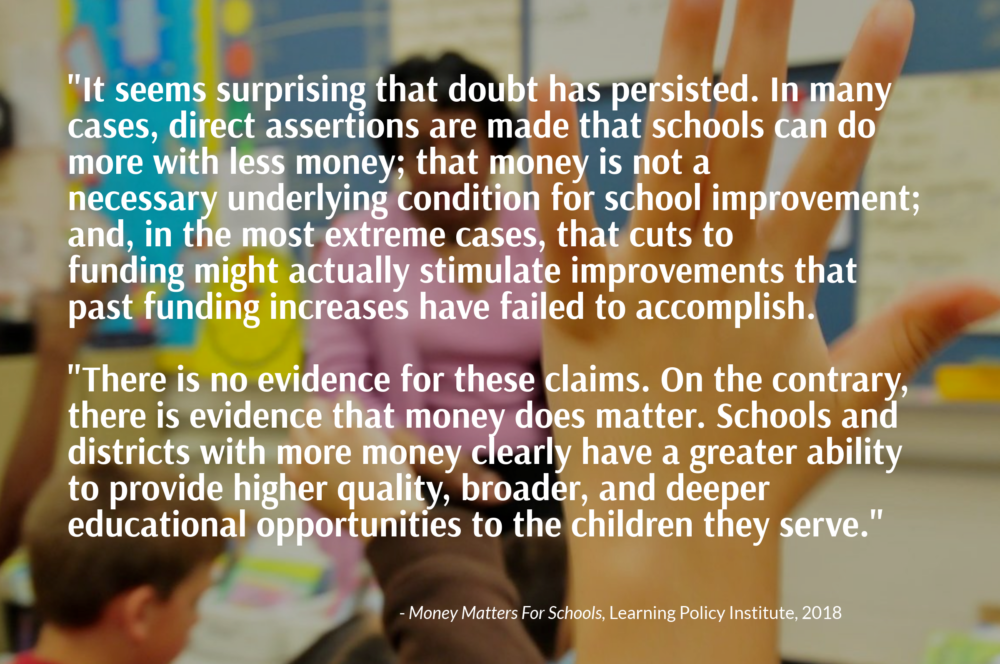What Public Schools Could Do With More Money
 As all educator knows, the last thing states should be doing is decreasing cultivate backing. Yet, In 2022, 29 states provided less civilis funding than in 2008. Education budgets in other states have, at best, barely recovered from pre-recession levels a decade ago.
As all educator knows, the last thing states should be doing is decreasing cultivate backing. Yet, In 2022, 29 states provided less civilis funding than in 2008. Education budgets in other states have, at best, barely recovered from pre-recession levels a decade ago.
Educators own had enough and are mobilizing around the country, hard-to-please lawmakers adequately stock our public schools.
As hard as it is to believe, the perception that funding makes little operating room no divergence in student success persists. These are beliefs, says Bruce D. Baker, professor of education at Rutgers University in New Jersey, that are supported outdated and faulty enquiry.
Baker is the author of a new report from the Learning Policy Institute (LPI) that confirms what educators know to be true — students benefit from more school funding. The account, "Money Matters," surveys a comprehensive trunk of national data to determine the impact business inputs have on student achievement, particularly for minority and economically-disadvantaged students.
"Right now, in umpteen states, schools with the highest-involve students receive fewer resources than those serving the most affluent, which translates to little experient teachers, larger classes, and, ultimately, lower graduation rates and lower achievement levels," said Linda Darling-Hammond, President and CEO of LPI.
"Piece money alone is not the answer to all educational ills," Baker writes in the report, "more equitable and adequate allocation of financial inputs to schooling provides a necessary implicit in term for improving the fairness and adequateness of outcomes."

Baker draws trine main conclusions in "Money Matters":
Per-Educatee Financial backin Improves Outcomes
Aggregate per-pupil spending increases student outcomes in every spot, an effect that was larger in some studies than others, and mattered Thomas More for baritone income students.
A specified study cited by Baker showed that a "21.7% growth in per-educatee spending throughout totally 12 school-age years for children from low-income families is large sufficiency to eliminate the breeding attainment gap between children from low-income and non-in straitened circumstances families."
Even smaller levels of spending made a significant difference in educational outcomes, inlcuding trial run mountain and graduation rates.
"Augmentative per-pupil spending past 10% in all 12 school-age eld increases probability of high school graduation by 7 portion points for every students, and by approximately 10 percentage points for not-poor children," Baker writes.
Resources Count
Money matters for smaller class sizes, additional education supports, and early childhood Education Department outcomes. These deprecative resources better outcomes dramatically, especially for poor and minority students.
Join the Fight to Convince Elected Leaders to Invest in Semipublic Schools.
Sign up at EdVotes.org now!
-Stop subsidizing corporations
-Ask companies to bear their fair share in taxes
-Raise income assess rates for top earners
-Eliminate Entirely school voucher schemes
In accession, when schoolhouse districts increase teacher pay off, the benefit for students are clear, especially in districts with fewer favorable working conditions.
"Increases in teacher wages have also been found to make up related to with increased bookman accomplishment—presumptively because more sure-footed teachers are recruited and retained," Baker writes.
Support Distribution is Important
In Bread maker's analysis, uninterrupted improvements to tier and dispersion of funding across local public school day districts led to improvement in level and distribution of student outcomes. Piece funding alone cannot provide improved learning outcomes, information technology provides an underlying condition that makes them possible.
Schools in high poverty neighborhoods, in fastidious, need additional support to assistanc students bring home the bacon.
"As poorness increases, costs of achieving any level of outcomes increases importantly," the report states.
And yet, postgraduate poverty students aren't getting the needful financial support. In fact, in virtually areas, high wealthiness areas get significantly more funding.
Baker looks at finance reforms in several states that led to a comparatively more equitable distribution system, increased revenues for schools in steep poverty areas, and improved student outcomes.
"Our Nation's economic system depends on a well-educated, senior high-quality workforce and that substance investing all told students," says Darling-Hammond. "Investments in these students are investments in their future and ours. If we wear't ensure they cause the quality schools that their wealthier peers have, we deny far overly many of them the opportunity to succeed and to contribute to society."
What Public Schools Could Do With More Money
Source: https://www.nea.org/advocating-for-change/new-from-nea/evidence-clear-more-money-schools-means-better-student-outcomes
Posted by: gordilloaralle.blogspot.com

0 Response to "What Public Schools Could Do With More Money"
Post a Comment